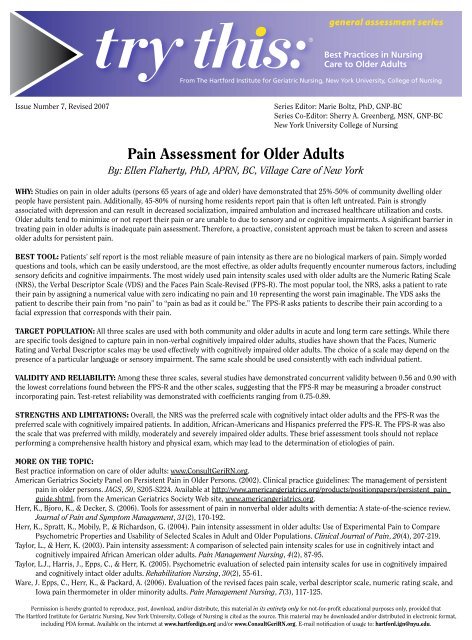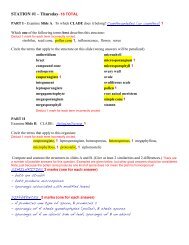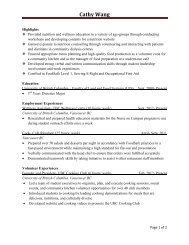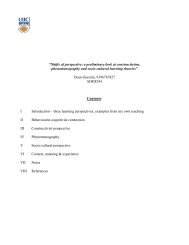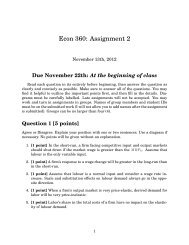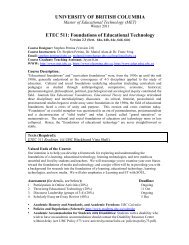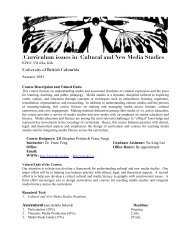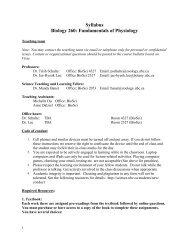Pain Assessment for Older Adults - UBC Blogs
Pain Assessment for Older Adults - UBC Blogs
Pain Assessment for Older Adults - UBC Blogs
- No tags were found...
You also want an ePaper? Increase the reach of your titles
YUMPU automatically turns print PDFs into web optimized ePapers that Google loves.
general assessment seriesBest Practices in NursingCare to <strong>Older</strong> <strong>Adults</strong>From The Hart<strong>for</strong>d Institute <strong>for</strong> Geriatric Nursing, New York University, College of NursingIssue Number 7, Revised 2007Series Editor: Marie Boltz, PhD, GNP-BCSeries Co-Editor: Sherry A. Greenberg, MSN, GNP-BCNew York University College of Nursing<strong>Pain</strong> <strong>Assessment</strong> <strong>for</strong> <strong>Older</strong> <strong>Adults</strong>By: Ellen Flaherty, PhD, APRN, BC, Village Care of New YorkWHY: Studies on pain in older adults (persons 65 years of age and older) have demonstrated that 25%-50% of community dwelling olderpeople have persistent pain. Additionally, 45-80% of nursing home residents report pain that is often left untreated. <strong>Pain</strong> is stronglyassociated with depression and can result in decreased socialization, impaired ambulation and increased healthcare utilization and costs.<strong>Older</strong> adults tend to minimize or not report their pain or are unable to due to sensory and or cognitive impairments. A significant barrier intreating pain in older adults is inadequate pain assessment. There<strong>for</strong>e, a proactive, consistent approach must be taken to screen and assessolder adults <strong>for</strong> persistent pain.BEST TOOL: Patients’ self report is the most reliable measure of pain intensity as there are no biological markers of pain. Simply wordedquestions and tools, which can be easily understood, are the most effective, as older adults frequently encounter numerous factors, includingsensory deficits and cognitive impairments. The most widely used pain intensity scales used with older adults are the Numeric Rating Scale(NRS), the Verbal Descriptor Scale (VDS) and the Faces <strong>Pain</strong> Scale-Revised (FPS-R). The most popular tool, the NRS, asks a patient to ratetheir pain by assigning a numerical value with zero indicating no pain and 10 representing the worst pain imaginable. The VDS asks thepatient to describe their pain from “no pain” to “pain as bad as it could be.” The FPS-R asks patients to describe their pain according to afacial expression that corresponds with their pain.TARGET POPULATION: All three scales are used with both community and older adults in acute and long term care settings. While thereare specific tools designed to capture pain in non-verbal cognitively impaired older adults, studies have shown that the Faces, NumericRating and Verbal Descriptor scales may be used effectively with cognitively impaired older adults. The choice of a scale may depend on thepresence of a particular language or sensory impairment. The same scale should be used consistently with each individual patient.VALIDITY AND RELIABILITY: Among these three scales, several studies have demonstrated concurrent validity between 0.56 and 0.90 withthe lowest correlations found between the FPS-R and the other scales, suggesting that the FPS-R may be measuring a broader constructincorporating pain. Test-retest reliability was demonstrated with coefficients ranging from 0.75-0.89.STRENGTHS AND LIMITATIONS: Overall, the NRS was the preferred scale with cognitively intact older adults and the FPS-R was thepreferred scale with cognitively impaired patients. In addition, African-Americans and Hispanics preferred the FPS-R. The FPS-R was alsothe scale that was preferred with mildly, moderately and severely impaired older adults. These brief assessment tools should not replaceper<strong>for</strong>ming a comprehensive health history and physical exam, which may lead to the determination of etiologies of pain.MORE ON THE TOPIC:Best practice in<strong>for</strong>mation on care of older adults: www.ConsultGeriRN.org.American Geriatrics Society Panel on Persistent <strong>Pain</strong> in <strong>Older</strong> Persons. (2002). Clinical practice guidelines: The management of persistentpain in older persons. JAGS, 50, S205-S224. Available at http://www.americangeriatrics.org/products/positionpapers/persistent_pain_guide.shtml, from the American Geriatrics Society Web site, www.americangeriatrics.org.Herr, K., Bjoro, K., & Decker, S. (2006). Tools <strong>for</strong> assessment of pain in nonverbal older adults with dementia: A state-of-the-science review.Journal of <strong>Pain</strong> and Symptom Management, 31(2), 170-192.Herr, K., Spratt, K., Mobily, P., & Richardson, G. (2004). <strong>Pain</strong> intensity assessment in older adults: Use of Experimental <strong>Pain</strong> to ComparePsychometric Properties and Usability of Selected Scales in Adult and <strong>Older</strong> Populations. Clinical Journal of <strong>Pain</strong>, 20(4), 207-219.Taylor, L., & Herr, K. (2003). <strong>Pain</strong> intensity assessment: A comparison of selected pain intensity scales <strong>for</strong> use in cognitively intact andcognitively impaired African American older adults. <strong>Pain</strong> Management Nursing, 4(2), 87-95.Taylor, L.J., Harris, J., Epps, C., & Herr, K. (2005). Psychometric evaluation of selected pain intensity scales <strong>for</strong> use in cognitively impairedand cognitively intact older adults. Rehabilitation Nursing, 30(2), 55-61.Ware, J. Epps, C., Herr, K., & Packard, A. (2006). Evaluation of the revised faces pain scale, verbal descriptor scale, numeric rating scale, andIowa pain thermometer in older minority adults. <strong>Pain</strong> Management Nursing, 7(3), 117-125.Permission is hereby granted to reproduce, post, download, and/or distribute, this material in its entirety only <strong>for</strong> not-<strong>for</strong>-profit educational purposes only, provided thatThe Hart<strong>for</strong>d Institute <strong>for</strong> Geriatric Nursing, New York University, College of Nursing is cited as the source. This material may be downloaded and/or distributed in electronic <strong>for</strong>mat,including PDA <strong>for</strong>mat. Available on the internet at www.hart<strong>for</strong>dign.org and/or www.ConsultGeriRN.org. E-mail notification of usage to: hart<strong>for</strong>d.ign@nyu.edu.
Faces <strong>Pain</strong> Scale – RevisedNumbers arenot shown tothe patient0 2 4 6 8 10From PAIN, 2001, 93, 173-183 “The Faces <strong>Pain</strong> Scale – Revised. Toward a Common Metric in Pediatric <strong>Pain</strong> Measurement,”by C.L. Hicks, C.L. von Baeyer, P.A. Spaf<strong>for</strong>d, I. van Korlaar, & B. Goodenough,. Reprinted with permission of the International Association<strong>for</strong> the Study of <strong>Pain</strong> ® .Note: This is a smaller sample of the actual scale. For further instructions on the correct use of the scale in order to get valid responses,please go to www.painsourcebook.caNumeric Rating ScalePlease rate your pain from 0 to 10 with 0 indicating no pain and 10 representing the worst possiblepain. ___________________Adapted from Jacox, A., Carr, D.B., Payne, R., et al. (March 1994). Management of Cancer <strong>Pain</strong>. Clinical Practice GuidelineNo. 9. AHCPR Publication No. 94-0592. Rockville, MD: Agency <strong>for</strong> Health Care Policy and Research, U.S. Department ofHealth and Human Services.Verbal Descriptor ScalePlease describe your pain from “no pain” to “mild”, “moderate”, “severe”, or “pain as bad as itcould be.” _ __________________________________________________________________________________________________________________________________________________________________________________________________________________________________________________________________________________________________________________________________Adapted from Jacox, A., Carr, D.B., Payne, R., et al. (March 1994). Management of Cancer <strong>Pain</strong>. Clinical Practice Guideline No. 9. AHCPRPublication No. 94-0592. Rockville, MD: Agency <strong>for</strong> Health Care Policy and Research, U.S. Department of Health and Human Services.general assessment seriesBest Practices in NursingCare to <strong>Older</strong> <strong>Adults</strong>A series provided by The Hart<strong>for</strong>d Institute <strong>for</strong> Geriatric Nursing,New York University, College of NursingEMAIL hart<strong>for</strong>d.ign@nyu.edu HARTFORD INSTITUTE WEBSITE www.hart<strong>for</strong>dign.orgCLINICAL NURSING WEBSITE www.ConsultGeriRN.org


